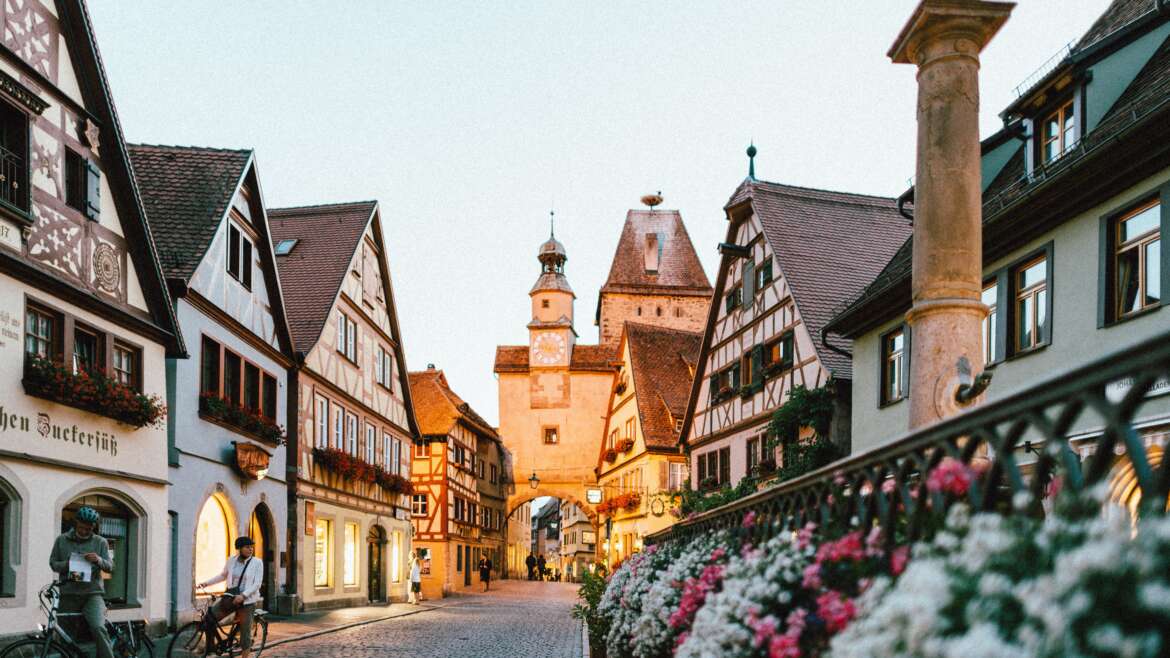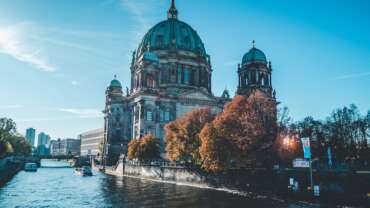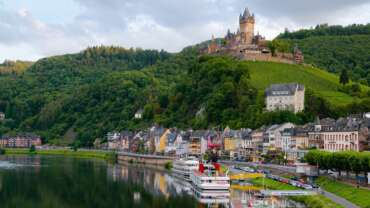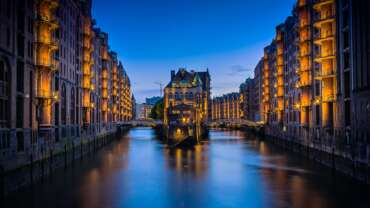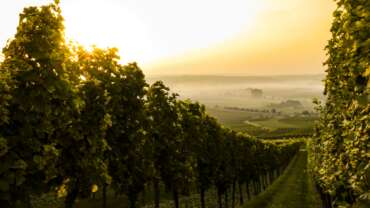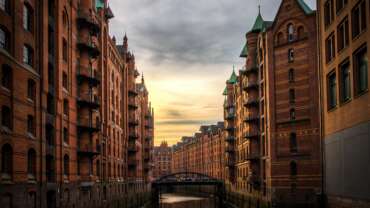Magic Cities of Germany
Bremen: Hanseatic and cosmopolitan
Bremen has many faces. The Hanseatic city is the beating heart of north-west Germany and home to the world-famous Town Musicians of Bremen. It is a multifaceted city where history, tradition, science, nature and culture come together in a blend that is fascinating without fail.
Bremen’s history as an episcopal city and a merchants’ settlement dates back to the 8th century. Alongside Bremerhaven, it forms the smallest federal state in Germany and wows tourists as a effervescent metropolis. This is a place where tradition meets modernity and urban quality of life meets northern German congeniality. Bremen is a compact city. In no other place are history, culture and lifestyle so interwoven as they are here. The historical Marktplatz square and surrounding streets are the city’s beating heart. The stone Roland statue on the square stands facing St. Peter’s Cathedral as a symbol of independence and is a UNESCO World Heritage Site alongside the magnificent Town Hall. Just a stone’s throw away, the Town Musicians of Bremen have been enshrined in bronze in their very own statue.
Visitors can walk along Böttcherstrasse and head towards the Schlachte promenade, where ships from all over the world once moored up. You can still see some great classic vessels here, including the Alexander von Humboldt. It is just a short walk from this promenade to Schnoor, a neighbourhood in the city’s medieval centre featuring narrow alleyways and must-see buildings. Or perhaps you’d prefer a stroll along the Culture Mile? Visit the internationally renowned Kunsthalle art gallery or take a quick trip into space with Airbus. It is also worth exploring Bremen by bike, where you can take relaxing breaks in the sprawling greenery and idyllic parks.
Cologne: joie de vivre at its finest
Cologne is known for its joyous attitude and party spirit. The city is a matter of the heart, an emotion and an unfalteringly positive state of mind. At the root of this outlook are Cologne Carnival, kölsch beer and, of course, the cathedral.
Just to pre-warn you, the period between the new year and Ash Wednesday is pretty exceptional in Cologne, as this is when the world-famous Cologne Carnival is held. The highlight of the event is the street carnival, where people celebrate, sing and dance in the pubs and bars around the Alter Markt and Heumarkt squares. Visitors will also notice the unique Cologne joie de vivre in the cosy, rustic pubs that serve kölsch, Cologne’s signature beer. The city on the Rhine also boasts a thriving music and art scene, making it a fun place to be. Highlights include Christopher Street Day, Musical Dome, the Wallraf Richartz Museum and the Ludwig Museum with its works by Picasso, Warhol and Lichtenstein.
Cologne Cathedral will most likely leave you speechless. It’s a UNESCO World Heritage Site and world-class religious edifice, landmark and hub of the metropolis on the Rhine. Countless legends also tell the tale of how Cologne’s twelve Romanesque churches came into existence. And before you let your hair down with high-spirited people in the student hang-outs such as the Kwartier Latäng or the Friesenviertel district, why not visit the Rheinpark, take the Cologne Cable Car over Germany’s longest river and see what joie de vivre looks like from above.
Dresden: synonymous with culture
There are many ways to define culture and beauty. But they can be easily summarised in just one word: Dresden. The sheer wealth and splendour of the cultural treasures just a stone’s throw from the Elbe plains are enough to take your breath away.
Although the attribute ‘world famous’ is dished out all too often, it is a befitting term for Dresden. The city is famed not only for its three major landmarks – the Baroque Zwinger Palace, Semperoper opera house and the Church of Our Lady – but also for Brühl’s Terrace and the Royal Palace, the Elbe Castles on the Loschwitz hillside, the exclusive villas of the Blasewitz borough, the garden city of Hellerau and, of course, the twelve Dresden State Art Collections. Here you will encounter treasures such as Raphael’s The Sistine Madonna and the Green Vault, the world’s largest treasure chamber.
Dresden is also famed for its music. The opera house, the Staatskapelle orchestra, the Dresden Philharmonic and the Kreuzchor boys’ choir all leave audiences enraptured. The cultural calendar is packed all year round, with the city hosting international festivals and captivating theatre and dance productions. In summer, the city flocks to open-air events in parks and on the banks of the atmospheric Elbe River. Dresden is more than just a city of history and heritage, as evidenced by several modern architectural masterpieces. If you happen to be in Dresden in December, be sure to visit Germany’s oldest Christmas market. The Striezelmarkt was first officially documented in 1434 and remains to this day a spectacular celebration of lights, colours and tantalising aromas.
Düsseldorf: Live close, feel free
Everything is close by in Düsseldorf: fashion, culture, entertainment – even the tolerant and cosmopolitan way of life that is cultivated here can be felt wherever you go. Take a seat in one of the famous craft breweries or stop for a break on the Rhine steps. You’ll soon discover that people love to chat.
Düsseldorf sets trends. It’s the fashion capital of Germany with more than 800 showrooms presenting the latest designer and couture creations – and not just during fashion week. The famous Königsallee, meanwhile, is lined with exclusive boutiques. Shoppers are known to succumb to temptation in the name of fashion here. The same sentiment is felt in Carlstadt, an idyllic borough full of antique shops, galleries and art dealers. And then there’s the Old Town with its laid-back vibe that has attracted unconventional fashion boutiques and numerous alternative stores to take up residence here. Not to mention the abundance of pubs, clubs and bars that has earned Düsseldorf Old Town the nickname of ‘the longest bar in the world’.
Culturally minded travellers are particularly well catered for here, with several theatres, concert halls, art galleries and places of historical interest, as well as magnificent parks and gardens. Wherever you go, you’ll encounter culture, with the museums and the acclaimed Düsseldorf Art Academy adding to the city’s reputation as a hub of culture. And if all that fashion, art and culture leaves you feeling worn out, you can head to Burgplatz to unwind in style. One of Germany’s most beautiful squares, it is Düsseldorf’s ultimate weekend and evening hang-out. So sit back with a glass of local Altbier, look out to the Rhine and just enjoy the moment.
Frankfurt: where tradition meets modernity
Frankfurt is a pretty modern city. It is home to businesses, skyscrapers and Europe’s third largest airport – all of which are state of the art. This may be why Frankfurt has a certain fondness for a wide array of museums. After all, the city is always a little ahead of its time but likes to keep records of it too.
When you think of Frankfurt, banks and the stock exchange are probably the first things to come to mind. And that’s not wrong. But it’s not all the city has to offer, as it also boasts an unrivalled wealth of museums. The museum embankment is a wonder to behold. The magnificent Städel Museum situated at the heart of Frankfurt’s museum mile is one of Germany’s preeminent art museums. It features masterpieces spanning nine centuries of European art, with the must-see underground extension housing a collection of works from 1945 onwards. The German Film Museum, Museum of Architecture and Schirn Kunsthalle art gallery are just three of the 60 or so other institutions, all of which focus on a different theme.
Frankfurt’s most famous son, Johann Wolfgang von Goethe, is omnipresent in the city. You can retrace his footsteps all over the place, including the Goethe House. And with the New Old Town, Frankfurt has reconstructed a part of the district destroyed during World War II just a stone’s throw from the cathedral and the Römer City Hall, the city’s landmark. It was a project of the century with picturesque prospects: 35 buildings, including 15 exact reconstructions, with shops and restaurants. From the New Old Town, it’s just a short walk to the banks of the Main River – the perfect place for a leisurely stroll. Or experience Frankfurt’s social and convivial side as you cross the iron footbridge and head towards the traditional bars serving Apfelwein cider.
Hamburg: a maritime metropolis that leaves you wanting more
The gateway to the world, a beautiful seafaring hub, the maritime capital of the north – even the normally reserved locals find it hard to conceal their pride in their home city, its ambiance and its cosmopolitan charm.
A boat trip around one of the world’s most powerful universal ports is at the heart of any successful trip to Hamburg. Followed by a stroll through the Old Town, with its beautiful angular buildings and 17th-century town houses, original restaurants and bars. The Speicherstadt district in the HafenCity inner-city development project is typical of Hamburg and has been named a UNESCO World Heritage Site. The buildings of the world’s largest single complex of traditional brick warehouses rest on thousands of oak supports and are intersected by narrow waterways. Just a stone’s throw away is the famous Elbe Philharmonic Hall, the city’s striking landmark and concert hall.
A very different kind of charm is on offer in the alternative quarter of St. Pauli with the Reeperbahn, its famous red light district. Or there’s the fish market in Altona, where fresh fish is auctioned every Sunday at the crack of dawn. The Jungfernstieg is Hamburg’s chic shopping and finance hub that begins at the Inner Alster Lake. Even here, at the heart of the city, you can take a stroll along the scenic waterside promenades. In the Blankenese district you will come upon the picturesque Treppenviertel quarter with its winding alleyways, beautiful buildings and many steps that take you straight to the Elbe ‘beach’. And if you’re thinking that the locals probably can’t get enough of the water, you’re spot on.
Leipzig: the city with an appreciation of music
Leipzig’s key role in setting the rhythm for the peaceful revolution of 1989 is testament to the city’s musical endowment. The most likely reason for Leipzig being named City of Heroes is the many great musicians, kapellmeister and composers who are arguably more popular and more prominent here than anywhere else in the world.
Leipzig comes across as if music was already running through the veins of the people and the walls of revered buildings way back in the 11th century. The city is home to the St. Thomas Choir, one of the world’s oldest boys’ choirs. But the Gewandhaus Orchestra and Leipzig Opera, one of Europe’s oldest opera venues, have also set the bar high as landmarks. Also second to none are the city’s famous virtuosos: Johann Sebastian Bach, the famous cantor of the St. Thomas Choir, as well as Felix Mendelssohn Bartholdy, Robert Schumann and Leipzig-born composer Richard Wagner.
What began with church services and demonstrations in and around St. Nicholas Church in the city centre grew into a movement that, in 1989, brought the GDR regime to its knees within a matter of months. One reason these events unfolded in Leipzig is surely because one of the most infamous headquarters of the much-hated Stasi was located here. A must-see exhibition now documents the work of official state security service operatives during the GDR. Back in the present day, you can have plenty of fun exploring the city’s shops and bars along the picturesque alleyways of the Old Town around the market square. But don’t be surprised if you have a tune stuck in your head as you browse or drink – you’re in Leipzig after all!
Nuremberg: Germany’s most vibrant museum of history
Impressive, exciting, colourful, mighty and tragic: Nuremberg has reflected German history since the Middle Ages. Protected by the castle, a new spirit enlivened the city at a time when few other places could offer such a quality of life. And the same is still true today.
Nuremberg and its castle: To this day, the city’s skyline is still dominated by the mighty fortress built in around 1140 during the reign of Emperor Konrad III. Nuremberg’s historical mile ends (or begins) at the castle and features ornately decorated churches, elaborate fountains and the Tucherschloss Museum. In stark contrast, other sites in Nuremberg serve as necessary reminders of the darker years in the city’s long history. They include the Documentation Centre at the former Nazi party rally grounds, where the National Socialists staged their vast marching processions, and Memorium Nuremberg Trials, where the chief perpetrators of the Nazi atrocities were tried and convicted in 1946.
Turning to happier thoughts, December sees the arrival of Nuremberg’s world-famous Christkindlesmarkt. Alternatively, there’s the Toy Museum, with exhibits dating back to the early modern period. The Germanic National Museum, meanwhile, delves even further back in time. Germany’s largest museum of cultural history, it contains 1.3 million fantastic exhibits that document changing times. The locals also show their love of tradition by enjoying the city’s staple snack, the Nuremberg rostbratwurst. Records indicate that these delicious little sausages have been served up here since the 14th century. Looking into their history really is a culinary delight.
Munich: putting the style into lifestyle
Lifestyle is a priority in Munich. It might be down to the clear blue skies or simply the city’s beauty, but one thing’s for certain: The people of Munich always like to show their best side, whether they’re in a beer garden, on one of the exclusive shopping streets, or in Bayern Munich’s stadium.
A city with a big heart, as suave as it is easygoing, buzzing and yet tranquil. Munich is Germany’s lifestyle capital. And on top of all this, it boasts one of the country’s most beautiful squares: Marienplatz, at the heart of the city and home to the Old and New Town Halls. The famous town hall glockenspiel is as much a part of the city’s identity as the Hofbräuhaus beer hall or the iconic Church of Our Lady with its green dome-crested towers. Browsing the stalls of the Viktualienmarkt is a feast for the senses, while the luxury shopping boulevards such as Ludwigstrasse or Maximilianstrasse are designed for those with an appreciation of the finer things in life. For a far more affordable, not to mention more relaxed, shopping experience, head to Munich’s trendy Glockenbachviertel district and Gärtnerplatz square.
A trip to the English Garden, Munich’s very own slice of paradise wedged in between the Isar River and the city centre, doesn’t cost you a penny. From the art of lazing around to surfing the Eisbach River, anything goes here. Add to this two of Munich’s most beautiful beer gardens, one at the Chinese Tower, the other at a picturesque lakeside spot, and you’ve got the perfect recipe for a relaxing afternoon. The people of Munich are also proud of the city’s museums, many of which are of international standing, such as the German Museum, the world’s biggest science and technology museum, the Alte Pinakothek, the Neue Pinakothek, the Pinakothek der Moderne, the Lenbachhaus Museum, the Brandhorst Museum and many more. The BMW Museum has the city’s automotive heritage covered, while the football stars of Bayern Munich show teams visiting the Allianz Arena what it’s really like to be on top. It’s well worth trying to get a ticket to see them play, as the stadium atmosphere alone is world-class.
Stuttgart: the perfect combination of culture and cars
There are cars you drive… and then there are cars you dream of. Stuttgart is one of the world’s best places for both – and not just because the world’s best cars are made here. Automotive history comes to life here like nowhere else on Earth.
The car has many fathers, but just one place it calls home. So it should come as no surprise that the Mercedes-Benz Museum is the only museum in the world to present the history of the automotive industry from start to finish. The motoring legends in the Porsche Museum also make heads turn. Every March, classic car enthusiasts from around the world descend on Stuttgart for Retro Classics, Germany’s best-loved motor show. Back in the present day, a tour of the Mercedes-Benz plant in Sindelfingen offers an in-depth look behind the scenes at a state-of-the-art car factory.
The surrounding wine region, one of the largest in Germany, plays a significant part in some of the locals’ other passions: exquisite food and fine wine. The perfect starting point for a sightseeing tour is the Schlossplatz square: In virtually no other city does a palace dominate the centre to such an extent as it does here. Those who have spent the day admiring the exceptional collection of modernist and contemporary art in the Art Museum Stuttgart can then enjoy a relaxing evening at the Stuttgart State Theatre, the world’s largest multi-genre theatre. Visitors can browse the world-class stores on Königstrasse and Calwerstrasse at their leisure. And take the time to discover the much-loved Wilhelma Gardens. These remarkable zoological and botanical gardens are home to around 8,000 animals, making this one of the world’s most biodiverse zoos.



